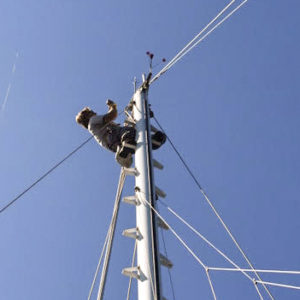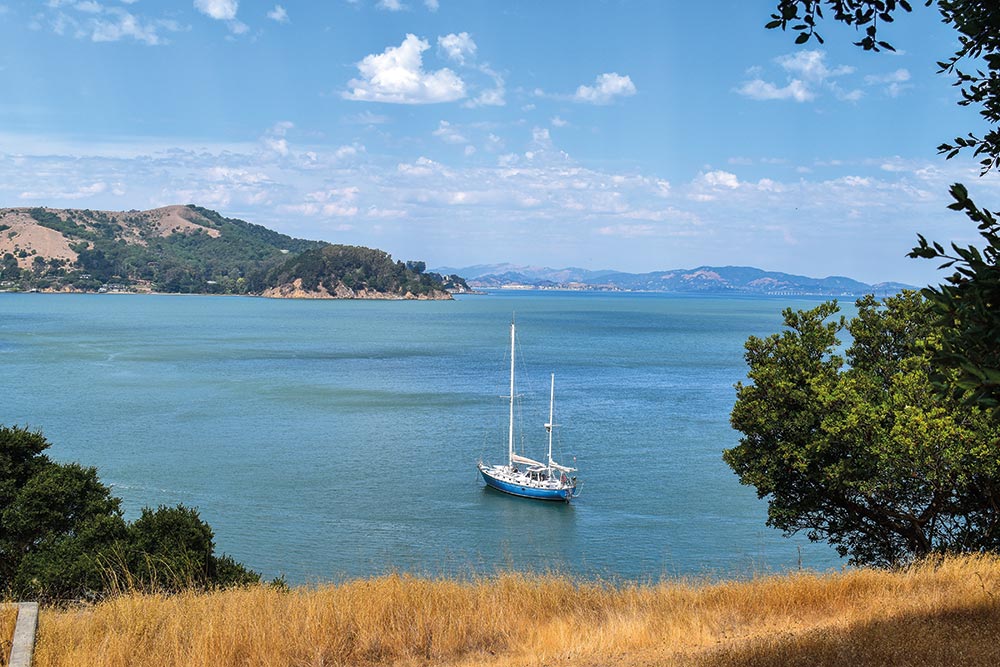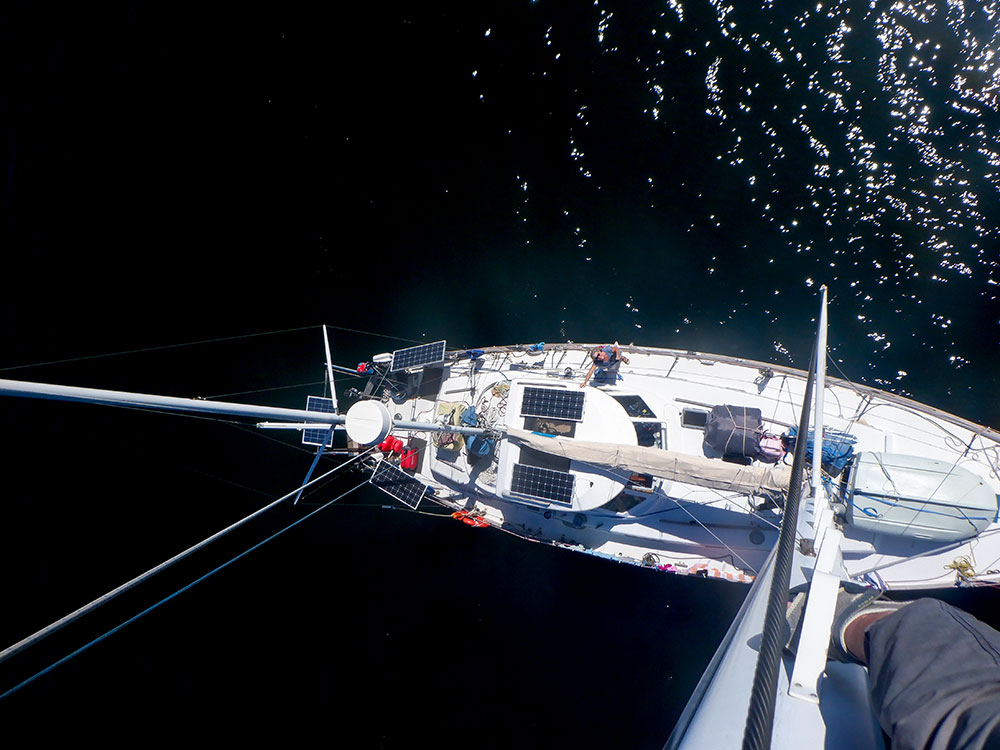When an emergency stop is required inbound from Hawaii, an American couple finds shelter across a closed border
From the October, 2020 issue of 48° North.
Five hundred lonely miles west of Cape Flattery, the sickening sound of cannon fire sounded through our Olympic Adventure 47, Galapagos. Then, our backstay—which had parted at the SSB insulator—came tumbling to the deck. It was July 23 and the idyllic part of our passage from Hawaii had abruptly, and scarily, come to an end.

After securing the rig, we motored on a rhumb line toward Cape Flattery, relieved we had a full tank of fuel since we had been sailing for the entire passage thus far. Our relief was short lived. The following day, forecasts showed gale force winds developing between us and the strait. Even on a good day, that didn’t sound like much fun. With a compromised rig, it sounded dangerous. We needed a plan, and fast.
We had these options: stay at sea in a probably-safe area that our weather router (Rick Shema) had forecast for us; or run to Vancouver Island, 150 miles away, and cross a closed border.
We had no sails up at this point. Our genoa was piled on deck and secured. Our mainsail was down. If we stayed at sea, we would be taking a chance that the weather would not get worse. We would have to stay within the defined area and keep a constant lookout for ships. If the front shifted toward us we would have to run somewhere else. Any way you sliced it, sitting at sea would be multiple days of very high stress for us and we were already fatigued.
Unsure how we would be received, we made the choice to dash for Vancouver Island and throw ourselves on the mercy of the Canadian government. It is customary for countries to help boats in distress, but these are not customary times.

FINDING REFUGE
Because we had ongoing communications with the United States Coast Guard, we felt confident that we had documented an actual need for safe harbor. So, a Canadian friend and fellow cruiser called the Joint Rescue Coordination Center (JRCC) in Victoria for us and they provided her with a direct number for us to call. Friends on the ground are invaluable during a passage, especially when things go wrong.
I spoke with an officer at JRCC who said we absolutely could land with no issue, asked details about our boat and crew, confirmed we did not currently need assistance, and wished us safe passage. We agreed to check in with the Coast Guard when we had landed. What a relief that was, just to know that we were on solid ground, as it were, landing our boat in Canada. Calling USCG on the radio we relayed that information, letting them know our destination was Clanninick Cove, a few miles below the Brooks Peninsula. It was well protected and there was no town in the cove, something we were keeping in mind due to the virus. They closed out our case and handed us off to the Canadian Coast Guard.
Three days after losing the backstay, we motored through the top of the weather system. It never got bad for us, with winds in the 17-20 range and swells about a meter on our aft quarter. The temporary fix was holding. By the time we were 15 miles offshore from the island, we were in sunny skies and what we considered benign sea conditions, breathing a huge sigh of relief. Checking in with Canada’s Coast Guard, we let them know our destination and asked if we needed to call Customs to check into the country, given the special situation we were in. They were noncommittal about that, but we decided calling would be prudent.
CUTTING THROUGH RED TAPE
This is where it would be nice to say that agencies work together and have the same goals in mind. All Coast Guard Canada cared about was our safety. If we needed to anchor, then we should anchor where we felt safe. Not so with Customs. Their job is different. It became clear that, while they understood that we needed to anchor for safety reasons, we were not to stay in the country one minute longer than necessary; and, in fact, our idea of what was necessary might be different than theirs.
We were the “one off” in their experience and, with bureaucracies, being the one off is not a good thing. It means the officers don’t have a box to check for your situation and they have to think about it and use their own judgement. They may not actually understand the predicament you are in because it might be pretty far outside their own experience. In addition, American boaters have been illegally sneaking across the border to enjoy British Columbia’s lovely cruising grounds during a time when they are most assuredly not welcome (see sidebar). They leave a dirty wake for those of us who are landing in a foreign country for legitimate safety reasons.
In our minds, we posed no threat to any community. We had been quarantined at sea for over three weeks and didn’t need provisions. We weren’t going ashore anywhere. We just needed a safe harbor until the winds died down enough for us to transit out of Canadian waters and back into the U.S. But, of course, all they would have is our word for that.
When my husband, Michael, called Customs, he spoke with a woman who was sympathetic to the situation, but didn’t quite know what to do with us. She put him on hold while she went to check. Eventually we were transferred to Customs in Victoria.
 GOOD COP, BAD COP
GOOD COP, BAD COP
The customs officer assigned to us was an interesting combination of Good Cop and Bad Cop. He was kind enough, but he wasn’t going to welcome us to Canada and check us in for an unhurried trip down the coast. Instead he asked how long it would take us to motor Galapagos out of Canada, to which Michael said, “Four days.” Of course, that’s four long days, and what Michael didn’t know is that his answer would define the number of days we were given to get out of the country. We had wanted to wait until the sea state died down to leave. Um, could we go back and do that conversation over again, please?

Then he came in with a litany of “Do NOT”s. Do not go ashore. Do not stop for any kind of supplies. Do not pull up to a fuel dock as you will be turned away. Do not linger. Stay away from populated areas. The ‘do not’ regarding fuel docks had me flummoxed. How can I leave the country if I need fuel but no one will sell it to me? That’s a bit contradictory. But these nuances get lost when customs officers are tasked with doing a tough job in unprecedented times. We understood their predicament, and decided to let that one alone, as we had plenty of fuel to get home. If we needed fuel, we would call either country’s Coast Guard or a towing service for assistance.
He also requested that we fly our quarantine flag. We both had a good laugh about that. We had a small ceremony with song as we raised the yellow flag to warn everyone that we had not been cleared and might be carrying germs, though three weeks offshore as a couple is about as socially distanced as it gets. The ceremony was witnessed by several sea otters, snacking on shellfish.
Sometimes frustrating, sometime funny, the red tape was as sticky as ever. Through it all, we were grateful to the various Canadian agencies who recognized our plight, and whose accommodation kept us safe.
HOMEWARD BOUND
Not only did we now need to leave right away, but we also were in the weird position of not being checked in to Canada, but also needing to check into the United States because the customs officer wanted proof that we were out of Canada and safely back in the number one country in the world for the Coronavirus: ours. We were neither here nor there! When you are asking for special permission you just do what is asked. We needed to close the loop with Canada by calling them and giving them our check in number from the U.S.
We left the following morning in sloppy swells and made one stop to anchor that night, making sure to avoid any of the First Nations lands. The next day, the weather cleared and the seas softened considerably so we decided to just get the trip over with and travel overnight down the coast and into Washington waters.
Galalpagos passed our starting point of Cape Flattery at midnight on July 29, coming full circle on our three years of cruising. We were both a little misty-eyed viewing the lights of Neah Bay from a distance. Yes, this was not how we had envisioned that moment, but here we were, safe in our home waters.
Thanks for the special accommodation and the genuine safety it provided, Canada. Maybe we can stay longer next time.
Enforcing a Closed border: A Cooperative effort
In late July, 48° North was contacted by George Creek of the Council of BC Yacht Clubs. He had been seeing US vessels illegally crossing the closed border to cruise Canadian waters. Members of the Council began documenting these sightings and reporting them to authorities. Often, these boats would have US registrations but would not be flying an American flag, and some were even flying Canadian flags and turning off their AIS to remain incognito. He expressed understandable concern about the spread of the Coronavirus, especially to small communities that have little or no medical services.
Following his contact with us, Mr. Creek went on to have his observations documented by publications around the US, including the Seattle Times, National Public Radio, and even Rolling Stone. 48° North recently caught up with Mr. Creek to see what has transpired in the last few months.
The Canadian agency charged with enforcing the closure is the Canada Border Services Agency (CBSA). Creek says he tried to communicate directly with CBSA and the Royal Candian Mounted Police (RCMP), but neither would respond to his queries or offer justification for their enforcement efforts, something 48° North also found to be true. CBSA typically does not publish incident reports, and statistics won’t come until later. Creek says, however, that he knows of one couple that was “fined for violating the border closure… and escorted to the border” on the west coast of Vancouver Island. He also said, “There have been various incidents up and down the interior on the Strait of Georgia.” He recognizes that CBSA has limited resources and equipment to monitor water crossings. In a typical summer he says, “They’re relying on the honesty of US boaters to check in by phone or in person.”
Considering these extenuating circumstances, Creek and the rest of the Council activated Canadian boaters to keep an eye out: “We put an alert out to all of our member boaters… and set up an email.” The reports started rolling in.
Creek says that he and others have noticed increased activity from enforcement resources that were available. “The RCMP have two patrol boats and they were out on a frequent basis. Canada Border Services hired [the vessel assist company] Sea Tow to provide transportation for them. Off Sidney Island, they’ve had a Sea Tow vessel with CBSA aboard virtually daily for weeks to monitor border crossings.”
Ultimately, Creek thinks that response from Canadian agencies and alert citizens have combined with the end of the busiest part of boating season—the result is an observed reduction in the number of US vessels in recent weeks.
Throughout the summer, it was still common to see American vessels in Canadian waters as they transited between Washington and Alaska. Creek says that most of these are professional crews (the fishing fleet or large luxury yachts), and that all are required to be in communication with CBSA. Like the extenuating circumstances in this article, those transiting vessels may be granted access to anchor or moor in the event of breakdown or severe weather. Generally, however, there should still be no American boaters recreating in Canada until the border official reopens.
Melissa White
Melissa White and Michael Boyte live and sail aboard their Olympic Adventure 47, Galapagos. They have just returned from a three-year cruise to Mexico and Hawaii so they can work, refit the boat, and keep voyaging.






